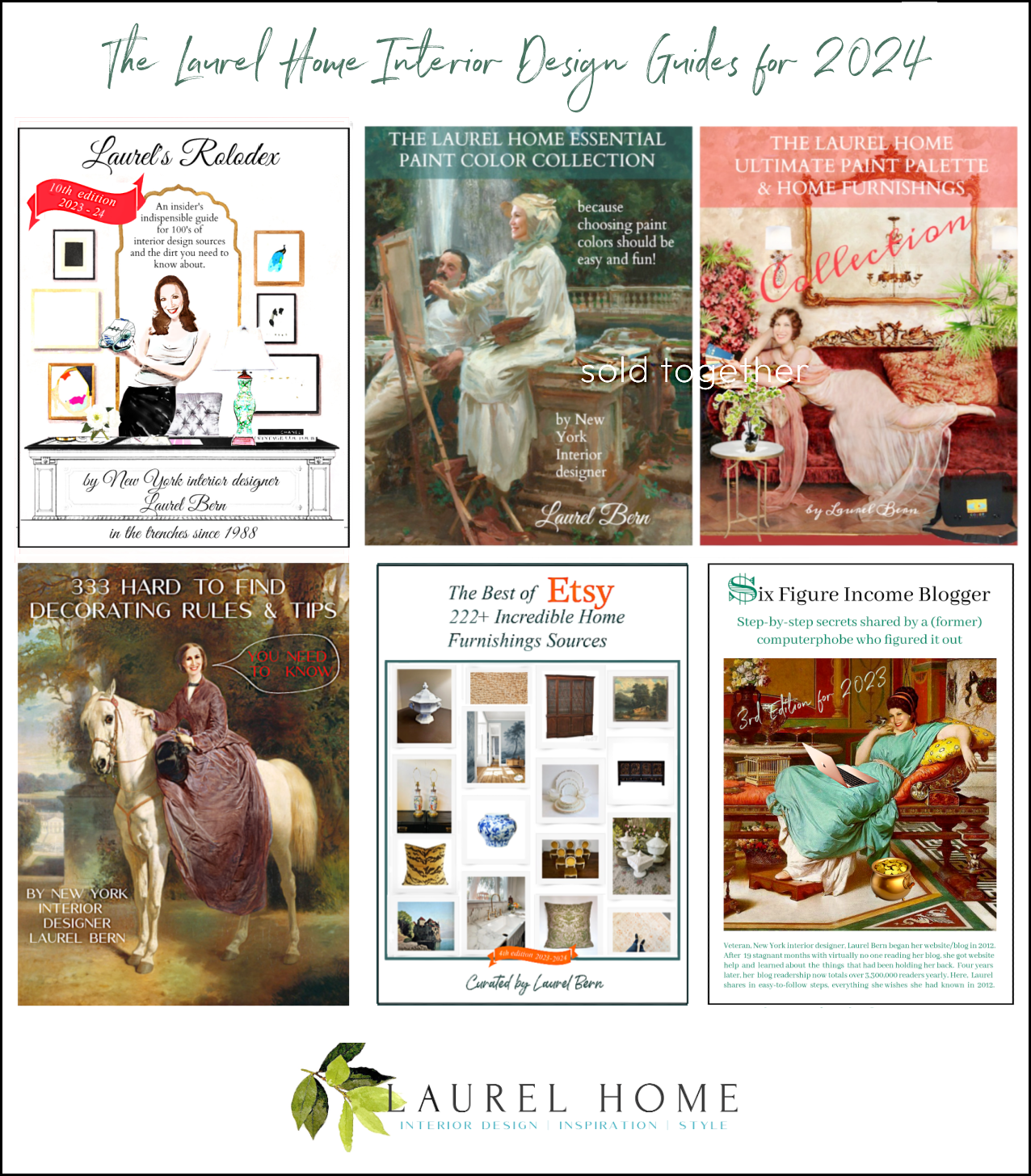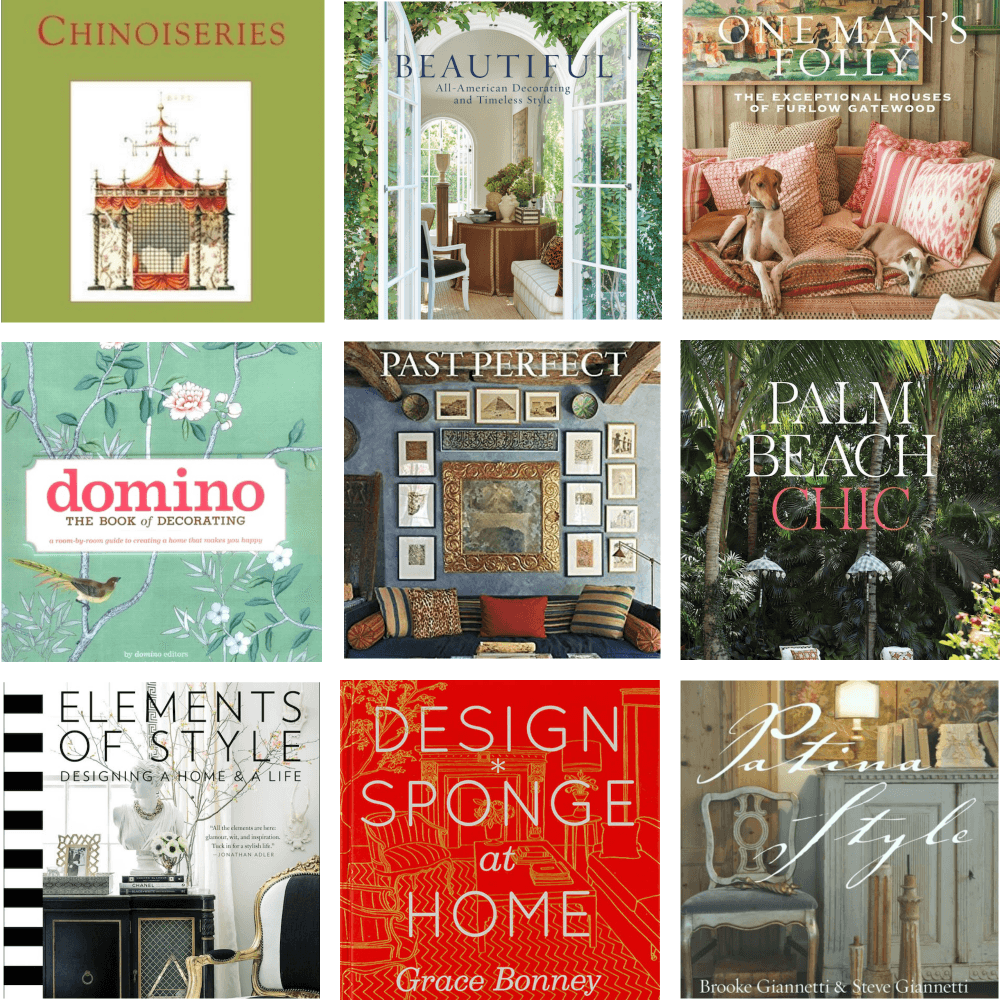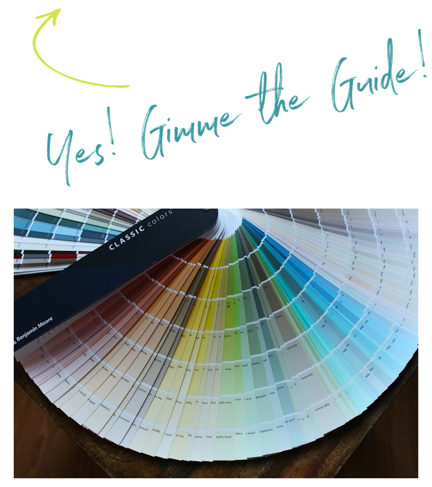Hi Everyone,
When I was thinking of a headline for this post, I debated over what it should be for quite a while. Finally, I settled on Stainless Steel Sucks.
I mean, I knew the post was going to focus around stainless steel and what the problem is. But, the reason it’s a problem is something I only JUST learned.
What I learned about stainless steel is quite disturbing. That’s why I’m deeming it public enemy number one.
Here’s what happened.
Recently, a kind reader named Janet sent me this note:
With the coronavirus on all our minds, and lots of us frantically disinfecting doorknobs and cabinet pulls, would you consider a round-up post on untreated copper and brass (which contains copper) hardware? Copper is anti-bacterial and anti-viral.
Apparently, Covid-19 stays viable on copper for 4 hours, but viable on plastics and stainless steel for 72 hours up to nine days. Numerous links available via google: here are a few:
Copper Destroys Viruses, So Why Isn’t It Everywhere?
Using Copper to Stop The Spread of Respiratory Viruses
Coronavirus Remains Infectious on Common Touch Surfaces
I read those, and a few other articles, and all concurred.
It’s true. Copper is naturally anti-microbial. And, even the really grungy oxidized version is as well. Did you know that? Yeah, probably. I was perhaps out sick with the flu the day we learned that in the eighth grade.
In addition to copper, brass, which is an alloy of copper and zinc, as well as bronze, which is an alloy of copper and tin are also anti-microbial.
Brass is about 67% copper. And Bronze is about 88% copper. Although, I could not find any studies about how long bacteria and viruses can live on those two surfaces.
But, it’s true. Bacteria and Viruses on copper surfaces die quite quickly– within four hours.
However, one of the worst materials where viruses can live for days on end is stainless steel. There are reports of four days and BEYOND!
I know. And, that’s why stainless steel sucks. Of course, I realize that we must always clean our surfaces unless you live alone. And, then you don’t have to clean anything. Haha, You’ll just recycle the same germs your body already knows and loves. Cool.
Logically, if stainless steel is so awful from a hygienic standpoint, how come it’s become so wildly popular for not only commercial kitchens but residential kitchens as well?
Good question, huh?
And not only that. But stainless steel is commonly used in hospitals as well. No wonder they say, “if you want to get sick, go to the hospital.”
I mean, scientists have known about this for a long time. So, tell me. Why isn’t the entire hospital made out of copper?
For this post, I’m focusing primarily on an alternative for stainless steel. And, also ways to use traditional copper.
Therefore, let’s begin with the ubiquitous stainless steel kitchen appliances.
Here’s what else is bothering me about stainless steel, and it’s brethren, like black stainless steel, for example.
I’m surprised that at least one kitchen appliance manufacturer hasn’t gone after a healthier surface. Now, that would be a reason to get a new range. Imagine a kitchen surface that is continuously ridding itself of bacteria and viruses? No bleach or other harsh cleaners. It is a surface that is inherently self-cleaning.
I’m not talking about spilling marinara sauce all over your countertop. No countertop will take care of that mess. I’m talking about cleaning the things you can’t see. Isn’t it ironic that something we can’t see is this enormous threat to our health and possibly our life?
Maybe germs just aren’t sexy enough for manufacturers? Well, how about now? Me thinks that now is the time we are going to see some significant changes in the home furnishings industry.
The reason is apparent.
Imagine you have three little kids who have been eating their buggers. And, then, they come into the kitchen to grab a glass of juice to wash them down. They smear their germy little hands all over that fridge, inside and out. Then, Mom comes along two hours later, to make dinner. She unknowingly picks up those germs on her hands that she just washed before beginning her dinner preparations.
Upon closing the fridge door, her eye suddenly begins to itch, and she starts rubbing it vigorously before realizing that she needs a Claritin. In the meantime, Mom just inoculated herself with thousands of viruses picked up from the fridge handle and door.
Three days later, Mom is sick with a bad cold.
But, what if the outside of the fridge had been made out of copper alloy? Most of the germs would’ve died before she got there. Yes, a few would be left. But, it takes an army of them to make you sick. I didn’t know that either. But, I’ve heard it on the news as a theory as to why some health care professionals are getting ill.
(please note that this is a little story I made up. People get infected with viruses in numerous ways. It depends on a lot of factors. And, I don’t have enough information to know if this could have happened or not. She also might’ve still gotten sick had the handle been made of copper or some other material. This is all meant to be food for thought. Thank you. )
Another really horrible material in terms of germ retention is plastic.
Oh dear. Plastic?
I’m sure that research is being carried out to figure out alternatives for stainless steel and plastic. These are two of the worst surfaces to use– anywhere.
But, one problem with copper is, do we want everything in our world to be the characteristic orangey-pinky color of copper?
Probably not.
So, then I wondered if it’s possible for copper to mimic the look of silver or stainless steel.
And, guess what? The answer is YES!
So, let me share this company that I discovered, and we’ll discuss their products. Or you can look them up below
CuVerro® is a solid surface that’s a unique class of copper.
They make sheets of the more traditional looking copper. However, I believe that it does not tarnish.
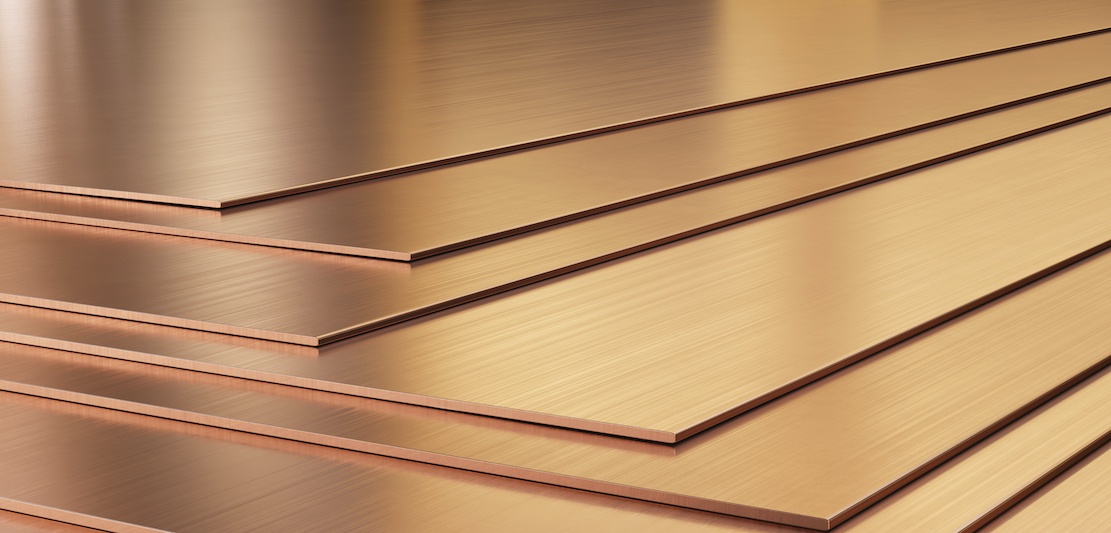
They make another copper alloy they call White Bronze
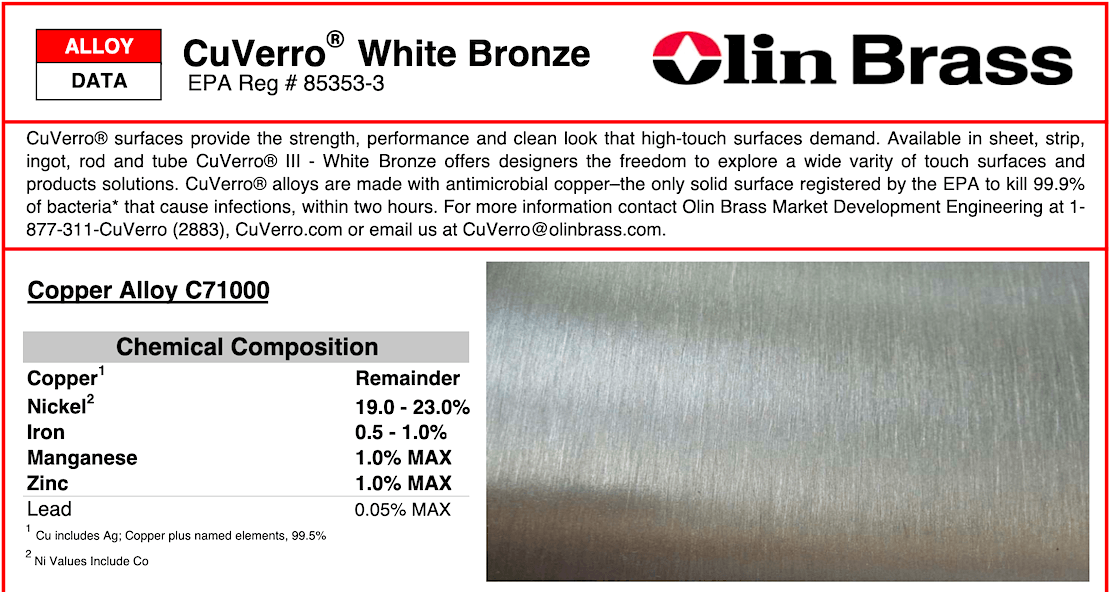
And below, I took a screenshot from their website that explains what it’s all about.
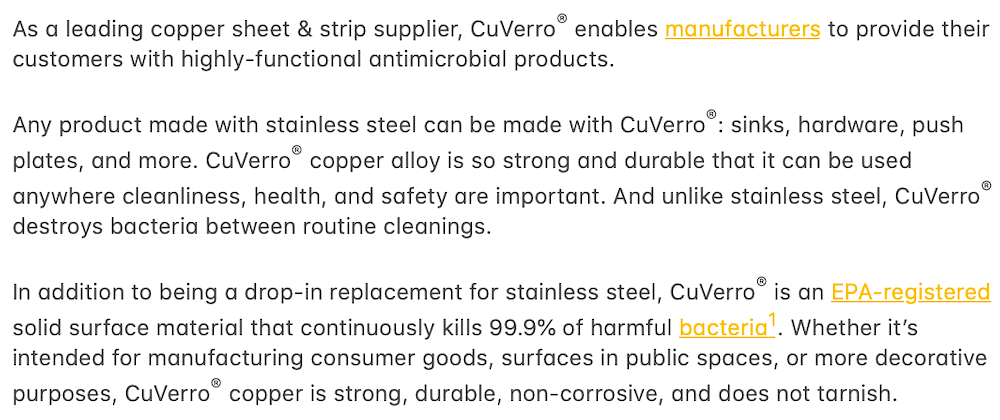
Do you see where it says that any product made with stainless steel can be made with CuVerro?
I did not know any of this before today.
There must be other manufacturers of a similar product. But, this is very exciting, indeed.
In fact, the basic idea of their white bronze is not new. There is a copper alloy called Cupronickel or Copper-nickel. Like the white bronze, it is also a copper alloy that is silver in color. Sometimes it is also called German Silver.
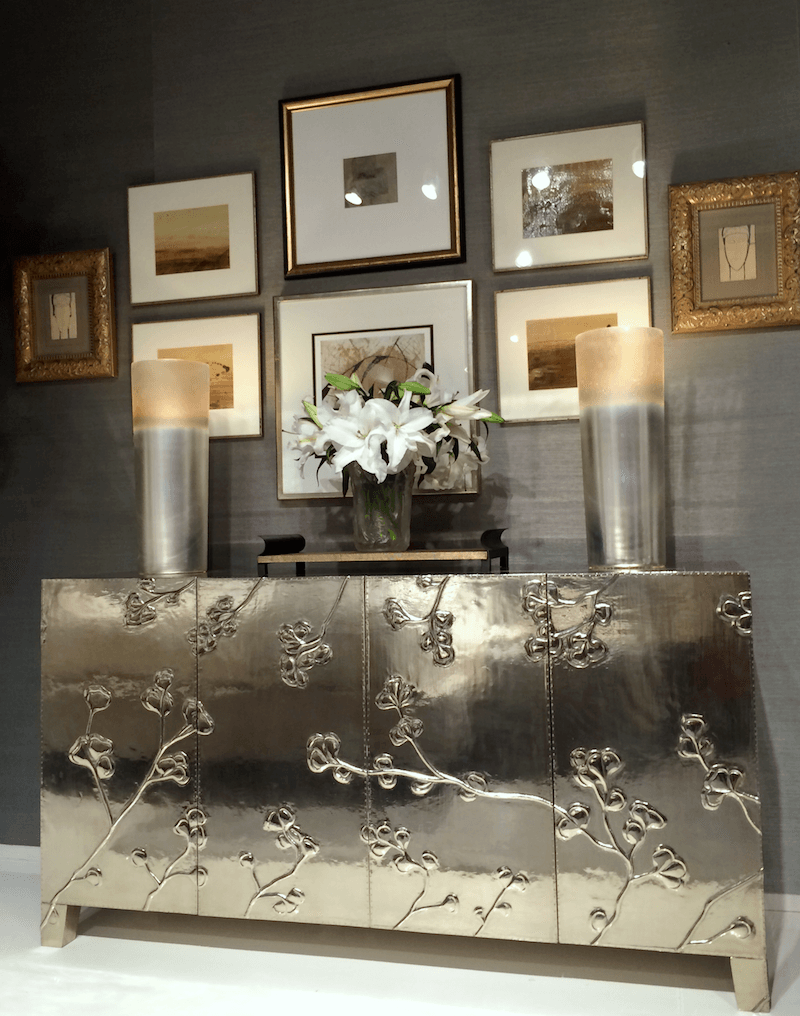
Years ago, I took this image in the Bernhardt Showroom at High Point of a credenza made from German Silver. Same thing. But, this one has a coating over it.
This silver-toned alloy of copper, nickel, and other metals has a multitude of uses.
But, common ones are for musical instruments or jewelry that is silver plated. Actually, anything that is silver-plated. It makes sense because if the plating wears off, the color won’t be significantly different.

Here is a piece of copper-nickel I found on Etsy.
In the meantime, although not common, I have seen some appliances with a copper finish.
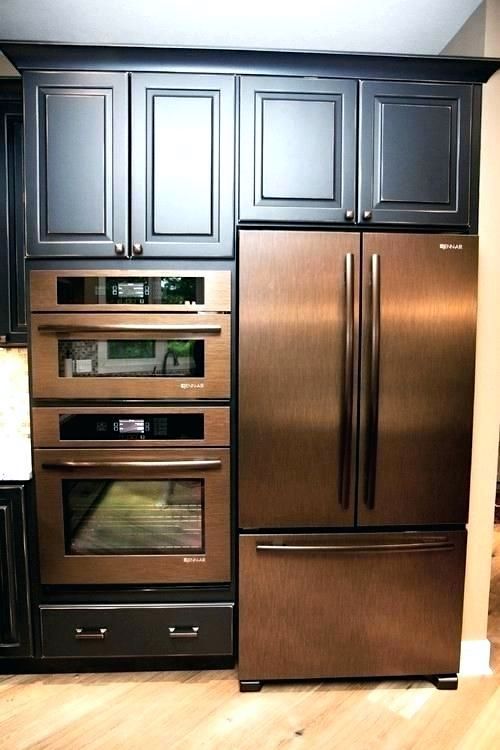 Sorry, source unknown. It seems a little heavy. I think I’d get sick of this look, pretty fast. But, the cabinet color is fine with the copper. Maybe if the fridge was clad in the cabinetry material, it would work better for me.
Sorry, source unknown. It seems a little heavy. I think I’d get sick of this look, pretty fast. But, the cabinet color is fine with the copper. Maybe if the fridge was clad in the cabinetry material, it would work better for me.
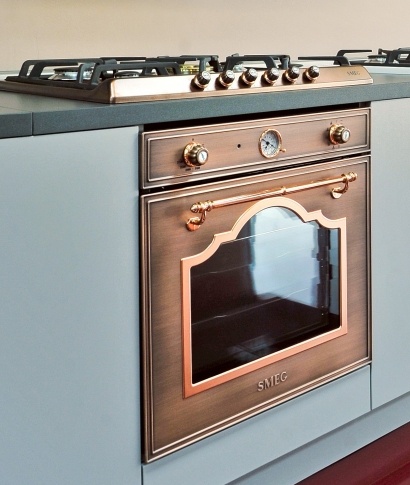
Interesting door.
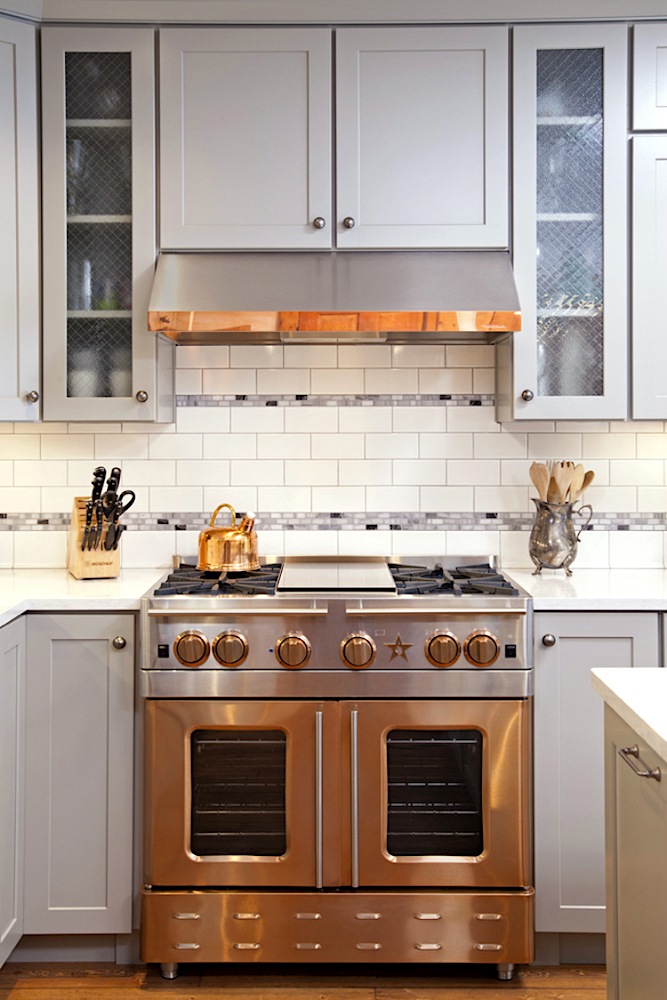 Bluestar makes a copper range. I love their line; remember this post from three years ago?
Bluestar makes a copper range. I love their line; remember this post from three years ago?
And, they were featured after my trip to KBIS in 2019.
But, I’m just not crazy about this orange-y metallic finish. I think I’d get sick of it pretty fast.
Below, is another example of a Bluestar copper range.

Uh oh… I hope whoever did this is not reading this post. I mean, they put a $6,000 range in a dated oak kitchen? And, to boot, it clashes with the more yellow-toned wood.
So, if you are going to do any copper appliances, what color cabinets would look best?
Well, before I get into that. Let’s talk about other places in the kitchen where one would use copper. And, I’m talking a more traditional copper.

Dixon – Photography by Erik Kvalsvik – Southern Home Magazine
Holy wow! A copper La Cornue. That’s some kitchen!
These items in the kitchen can be made out of copper or a copper alloy:
- countertops
- sinks
- hardware
- plumbing fixtures.

And, Williams Sonoma has a slew of small appliances and cookware made from copper.
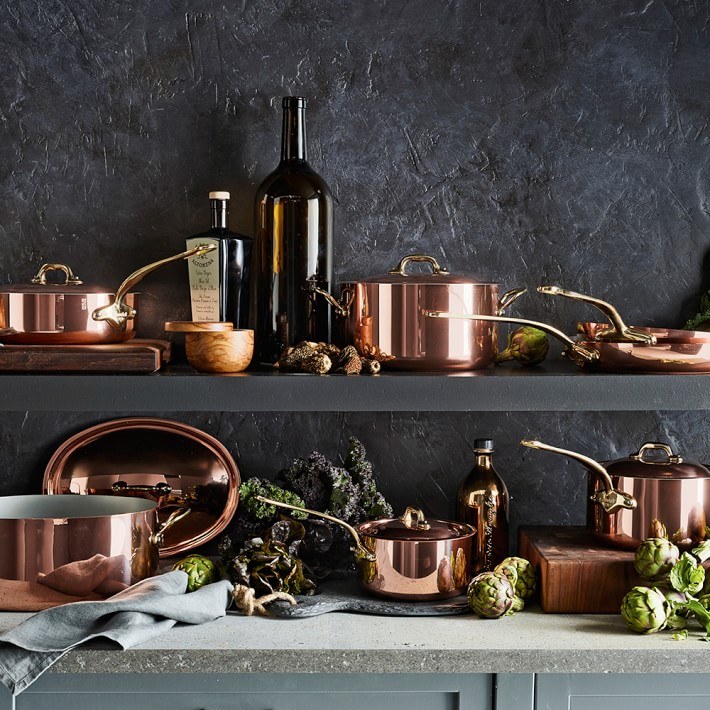
Mauviel Copper 12-piece cook set
Can you mix metals? Yes, absolutely. In fact, I think you should. You know, I thought we discussed this topic. But, I can’t find it now. Sorry about that.
But, there are few ideas in the following images, at least. We’ll also go over some of the best colors to go with copper finishes.
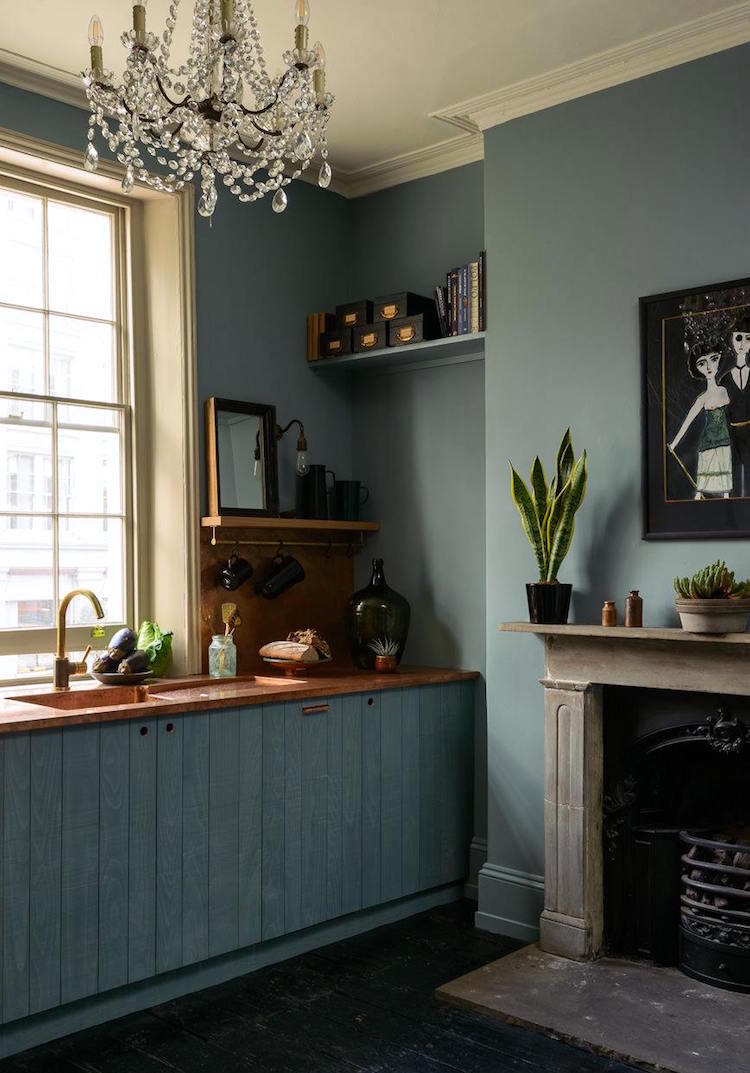 Remember this beauty from DeVOL? I love dark greens, teals, and dark blues with copper.
Remember this beauty from DeVOL? I love dark greens, teals, and dark blues with copper.
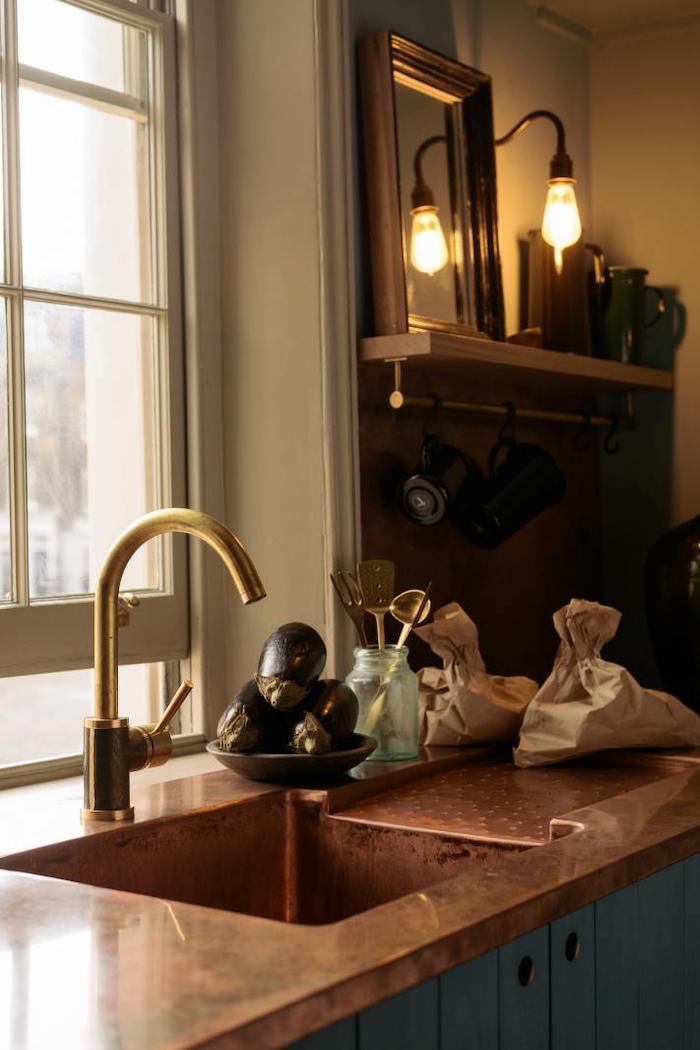
Above is a detail shot, showing the brass faucet, integrated copper sink, and countertop.
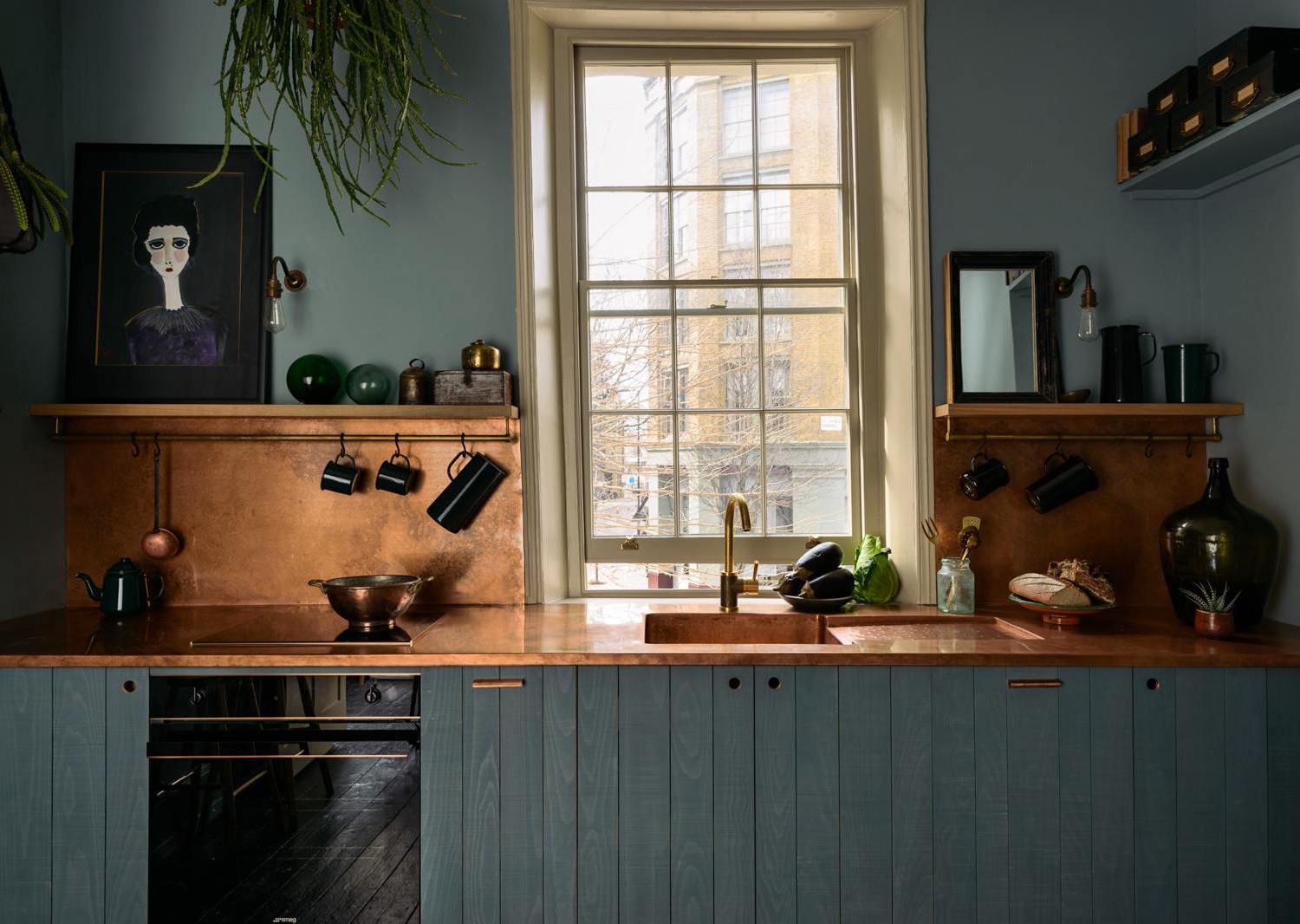
Another shot of the beautiful DeVOL kitchen with a copper backsplash, countertops, teal cabinetry. And, I love the black accents. Beautifully done!
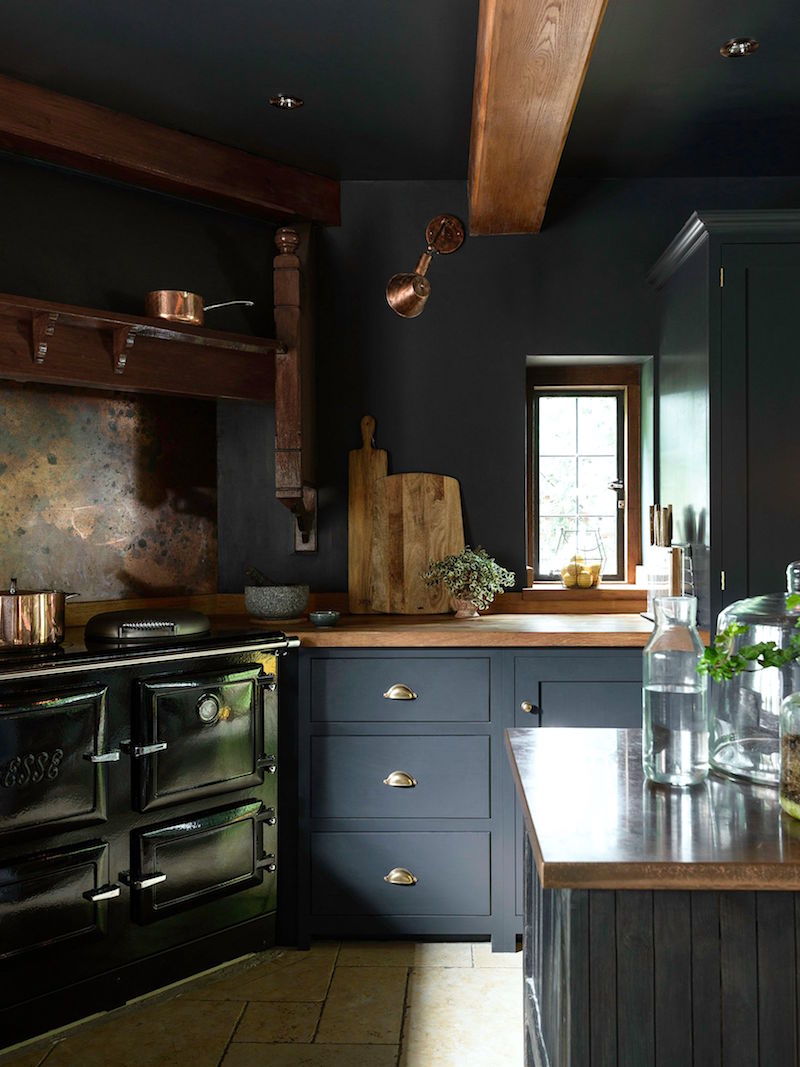
While the perimeter countertops appear to be wood, the island might not be. In any case, they could be copper. And, that would look lovely with the dark, cool gray cabinetry.

Another lovely DeVOL vignette. I believe that the taps are brass; the sink is copper, of course. And, the hardware appears to be copper too.
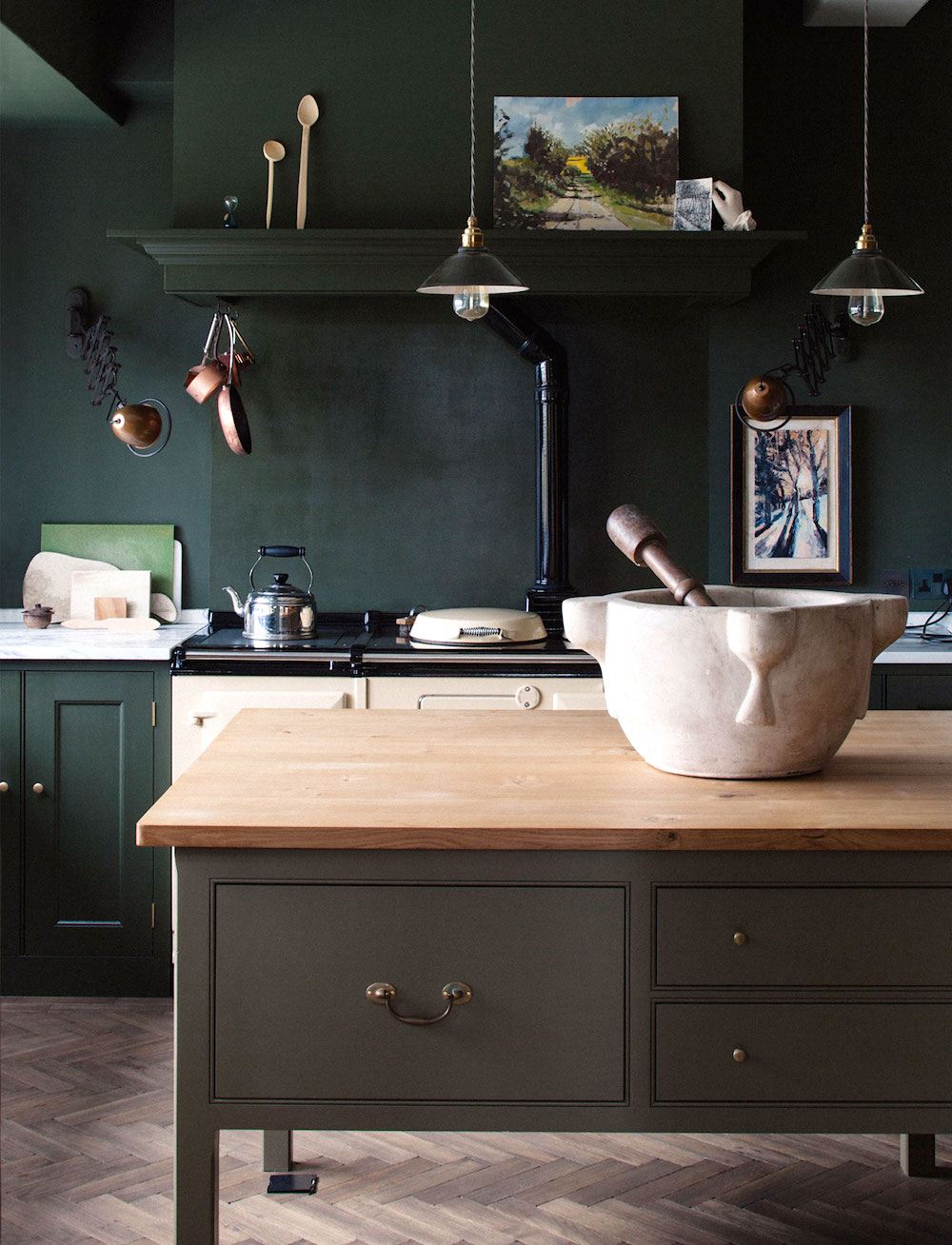
I think that copper would look great in this kitchen by Plain English Kitchen.
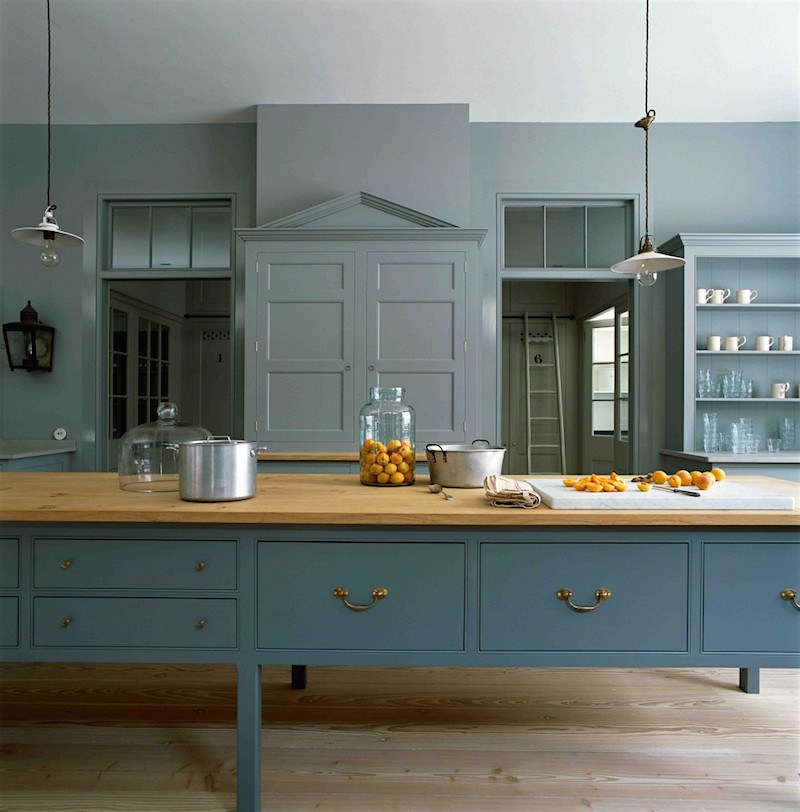
It’s difficult to tell but in this kitchen by Plain English Kitchen (one of my favorite blog posts), the hardware appears to be copper.

And, one last image from DeVOL with wonderful copper pulls and knobs. I love the colors they use for their cabinetry. For similar colors, please check out this post where I attempted to crack the code, using Farrow and Ball paint colors. This cabinet color looks a lot like Farrow and Ball Down Pipe.
If you’d like to see Farrow and Ball paint colors compared to Benjamin Moore, go here.
 Philippe Côté – blue and copper accents in a stunning kitchen
Philippe Côté – blue and copper accents in a stunning kitchen
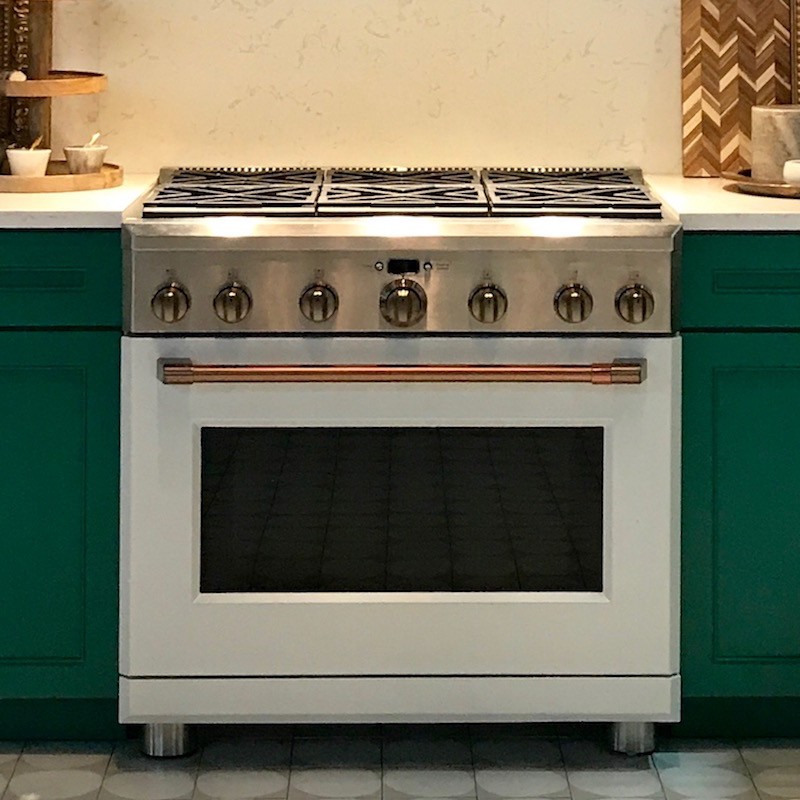
Remember the cafe matte white colorful kitchen appliances – mixed metals.
You might want to know if I think that a copper range would look good in a white kitchen. My opinion is to stick with the accents.
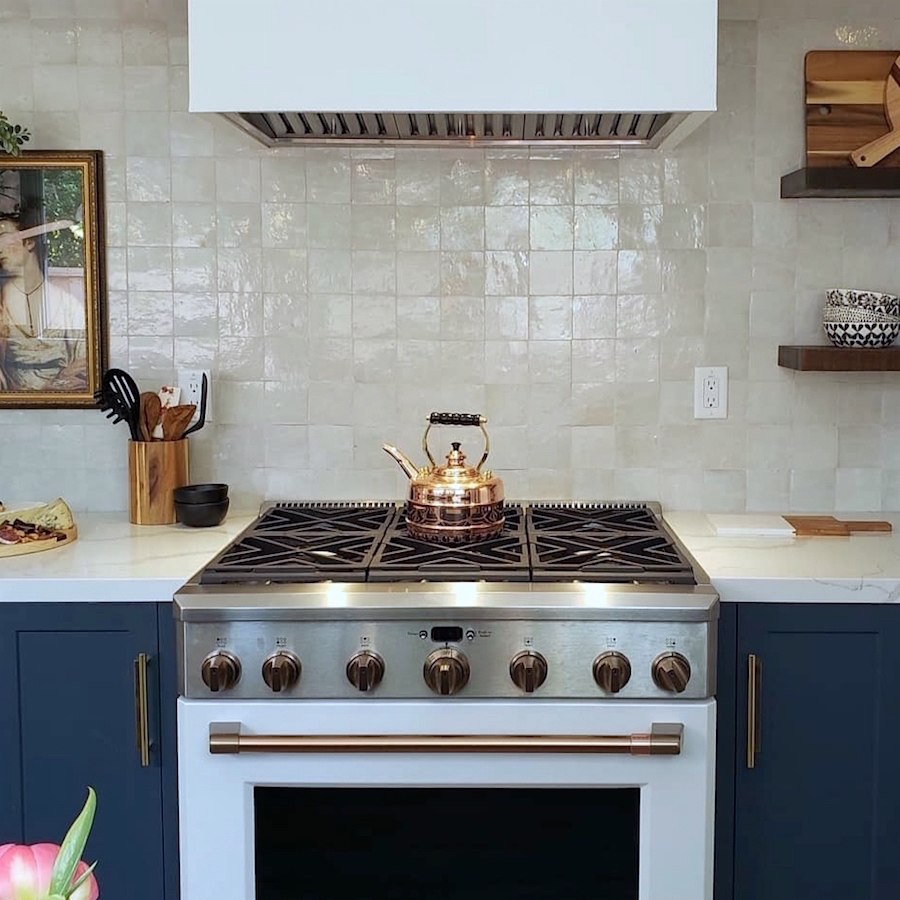 Kismet House – kitchen remodel – Cle Tile – cafe-appliance-range – Another fabulous kitchen.
Kismet House – kitchen remodel – Cle Tile – cafe-appliance-range – Another fabulous kitchen.
For more of the gorgeous Zellige tile, go here.
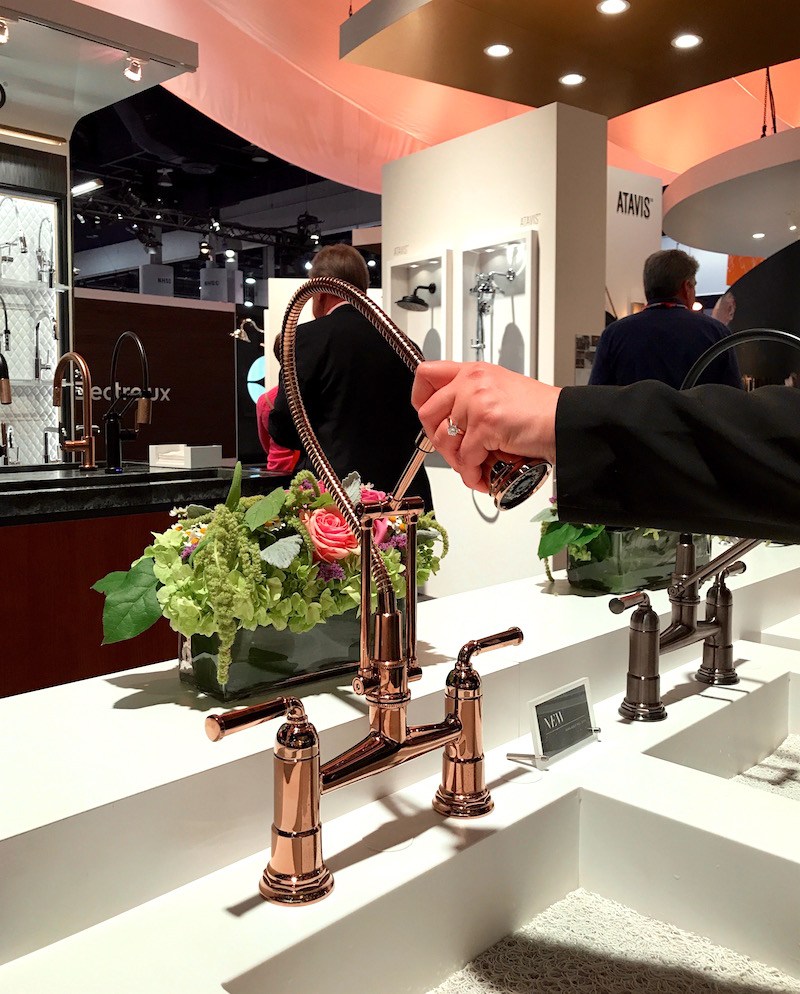
Brizo rose gold or copper faucet at KBIS 2019
In conclusion. I am curious to see what innovations will be happening in the home furnishings industry due to the virus.
And, for once, I’m actually excited about it. The reason being that these innovations will be done to make our homes safer as well as beautiful.
These will become the new trends that are based on function and need, not just because a manufacturer is trying to sell something new.
Of course, I’ve only begun to scratch the surface of materials that go in our kitchens. I didn’t go into all of the countertop materials and which ones are the best in terms of antimicrobial properties. That’s a different post.
But, one thing I predict is that we’re going to be seeing a lot more of the cupronickel products, or something similar to replace stainless steel.
I think that when the word really gets out that viruses can live on stainless steel for four or more days, there will be a demand for a different material. Well, that’s what I’m predicting.
We’ll just have to wait and see what happens when the dust of dead germs falls.
I hope everyone is keeping safe and well.
Note: 10 hours after publishing.
A few of you are being downright nasty in your comments.
Please stop, before you lash out in any way, even if you feel justified. You aren’t. Not on this blog. This is my digital home and you are my family. In my family, we speak to each other respectfully, at all times.
Go beat up your pillow if you’re angry. I hate having to delete comments. You don’t have to agree with anything I say. You don’t have to understand my point, either.
The only thing I ask for is kindness. We are all under a lot of stress. Please, let’s just try to love each other instead of tearing apart. Unfortunately, I’ve had to delete several comments. If it persists, I will turn the comments off.
xo,

PS: Definitely, check out the HOT SALES pages this week.
And, especially the Mother’s Day gift guide on the HOT CLOTHES PAGE.
Delivery times are far slower than usual, and this is the time to order Mom a gift if you’re planning on getting her one. Also, you’ll see a mini widget on the main Hot Sales page for a fabulous sale of Juliska products.
In addition, I’m going to be making a beautiful flower guide for the most stylish flowers and plants to get Mom. You’ll want to order soon, and then state when you want them to arrive. I’ll have that ready to go on Tuesday. In the meantime, you’ll see a few ideas for you to ponder.
Related Posts
 How I’m Developing My Interior Color Palette (Parts 1 and 2)
How I’m Developing My Interior Color Palette (Parts 1 and 2) Laurel, Why Does My Decorating Look So Awful?
Laurel, Why Does My Decorating Look So Awful? The Guaranteed Way To A Beautiful Room (It’s Not The Wall Color)
The Guaranteed Way To A Beautiful Room (It’s Not The Wall Color) The Magnificent Front Doors of Beacon Hill
The Magnificent Front Doors of Beacon Hill Hate Your Open Concept Floor Plan? Here’s How To Fix It
Hate Your Open Concept Floor Plan? Here’s How To Fix It Furniture Terms You May Not Know, But Maybe Should
Furniture Terms You May Not Know, But Maybe Should The Classic Kitchen – A Complete Source List
The Classic Kitchen – A Complete Source List












